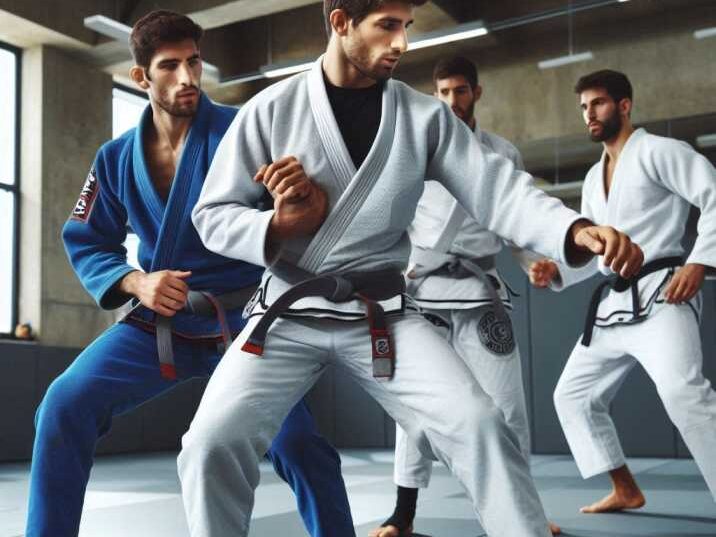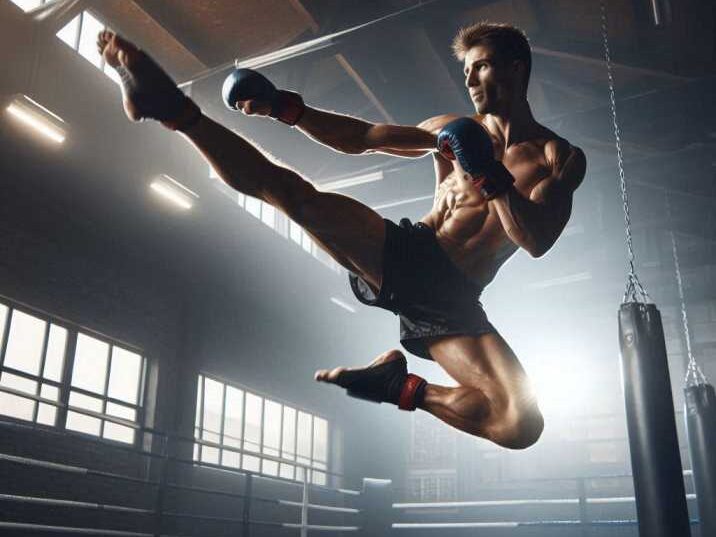Introduction
Table of Contents
Brazilian Jiu Jitsu (BJJ) and Muay Thai are popular martial arts known for their powerful techniques, fitness benefits, and self-defense skills. Many people are curious about which martial art is better suited for their interests and goals. In this article, we’ll dive into each style, focusing on their unique features, benefits, and differences between Brazilian Jiu Jitsu vs Muay Thai. By the end, you’ll have a clear idea of what each martial art can offer and which one might be right for you.
What is Brazilian Jiu Jitsu (BJJ)?
Brazilian Jiu Jitsu, or BJJ, is a martial art that focuses on grappling and ground fighting. Practitioners learn to control opponents through various techniques such as joint locks and chokes. Unlike some martial arts that emphasize strikes, BJJ is all about technique, leverage, and skill.

Key Techniques in Brazilian Jiu Jitsu
- Submissions: Submissions are techniques designed to control an opponent and force them to “tap out,” signaling defeat. Moves like arm bars and chokeholds are common submissions in Brazilian Jiu Jitsu. These techniques target specific joints or apply pressure to the neck, requiring skill and timing rather than brute strength. Practitioners learn to use leverage to make these moves effective, allowing smaller individuals to control much larger opponents. Submissions are crucial in both sport competitions and self-defense situations.
- Sweeps: Sweeps are techniques used to shift from a less favourable position to a dominant one, often while on the ground. For example, a practitioner may use a sweep to flip an opponent from the top position to the bottom, gaining control. This technique requires a solid understanding of balance and timing, as it often involves redirecting the opponent’s force. Sweeps are valuable in both sparring and real-life scenarios because they give the practitioner the advantage, positioning them better for further techniques or submissions.
- Escapes: Escapes are defensive moves that allow a practitioner to break free from an opponent’s control or escape a bad position, like being pinned underneath. Learning escapes is essential because it teaches practitioners to stay calm under pressure and regain control. These techniques often involve strategic movements and the use of leverage, making them accessible for individuals of all sizes. Escapes are a core part of BJJ training and improve both self-defense skills and confidence.
Benefits of Brazilian Jiu Jitsu
- Self-Defense Skills: BJJ equips practitioners with practical, highly effective self-defense techniques, even against larger opponents. Since BJJ focuses on grappling rather than striking, it allows a practitioner to control an attacker without causing serious harm. This makes it especially useful in real-life situations, where de-escalation is often preferred. Through BJJ, practitioners learn how to control distance, manage stress, and handle confrontations safely.
- Confidence: Training in BJJ builds confidence by teaching individuals how to defend themselves and handle difficult situations. Mastering techniques like submissions, sweeps, and escapes instils a sense of accomplishment and resilience. As practitioners develop their skills, they become more comfortable with facing challenges, both on and off the mat. This increased self-confidence can positively impact other areas of life, from personal interactions to public speaking.
- Mental Strength: Practicing BJJ requires focus, discipline, and patience, as each technique needs to be mastered through repetition and determination. This mental training translates into improved concentration, making it easier for practitioners to stay focused in school, work, or other activities. The challenges faced in BJJ also encourage resilience and perseverance, teaching individuals to push through setbacks. This development of mental strength is one of the most valued aspects of Brazilian Jiu Jitsu training.
What is Muay Thai?
Muay Thai, often called “The Art of Eight Limbs,” is a martial art from Thailand that combines punches, kicks, knees, and elbows for a dynamic and powerful fighting style. It’s known for its high-energy training and is widely used in MMA (Mixed Martial Arts)
Key Techniques in Muay Thai
- Punches and Elbows: Muay Thai uses punches and elbow strikes for short-range attacks and defensive moves. Elbows are especially powerful in close combat, as they can cause cuts or knockdowns. Unlike traditional boxing, Muay Thai emphasizes using elbows at close range to surprise and overwhelm opponents, making it a highly effective tool for both offence and defence.
- Kicks: Kicks in Muay Thai, particularly high kicks and leg kicks, are delivered with precision and force. Practitioners often aim for the legs, ribs, or head, using kicks to weaken the opponent or limit their movement. Kicks are powerful and can cover longer distances, allowing fighters to keep opponents at bay while inflicting substantial damage.
- Knee Strikes: Knee strikes are powerful close-range attacks used frequently in clinch fighting, where fighters are locked together. Knees target the body and ribs, making them highly effective for weakening an opponent. Muay Thai fighters train to deliver quick and accurate knee strikes, often surprising their opponents in close quarters and gaining an upper hand.
- Clinching: Clinching is a distinctive aspect of Muay Thai that involves controlling the opponent’s posture and movement at close range. While in the clinch, fighters can deliver knee strikes, elbows, and even short-range punches. Clinching requires both strength and technique and mastering it can give a fighter significant control over an opponent during a match.
Benefits of Muay Thai
- Cardiovascular Fitness: Muay Thai is an intense workout that boosts cardiovascular health through high-energy routines. The fast-paced striking drills and constant movement keep the heart rate elevated, improving endurance and overall heart health. As a result, practitioners often experience improved stamina and lung capacity.
- Full-Body Strength: Muay Thai training emphasizes the use of different striking techniques, helping practitioners develop strength throughout their entire body. Each movement, from kicks to punches, engages various muscle groups, including legs, arms, and core. This leads to well-rounded muscle development and improved physical power.
- Increased Agility: The quick movements, balance, and reflex training in Muay Thai enhance a practitioner’s agility. By practising footwork and quick strikes, fighters learn to react and adapt instantly, which sharpens reflexes and balance. This increase in agility is beneficial for both Muay Thai and everyday activities requiring coordination and fast reactions.
Comparing Brazilian Jiu Jitsu and Muay Thai:
| Feature | Brazilian Jiu Jitsu (BJJ) | Muay Thai |
|---|---|---|
| Primary Focus | Ground grappling and submissions | Striking with punches, kicks, knees, and elbows |
| Fitness Benefits | Strengthens core and flexibility | Improves cardio and overall strength |
| Best For | Those interested in ground control and self-defense | Those interested in striking and fast-paced training |
| Mental Benefits | Builds patience, discipline, and focus | Boosts confidence and reduces stress |
| Self-Defense | Effective for controlling larger opponents | Effective for striking and quick escapes |

BJJ vs Muay Thai: Training Styles
Brazilian Jiu Jitsu Training Style
BJJ training usually involves practicing with a partner to develop techniques. Each session focuses on specific movements, which are later practiced in “rolling” or sparring sessions. Since BJJ emphasizes skill and technique over raw strength, it’s accessible for people of all ages and sizes.
Typical Training Structure:
- Warm-Up: Light stretching and drills.
- Technique Practice: Focus on a specific technique like a sweep or submission.
- Drills: Practicing movements repeatedly to build muscle memory.
- Rolling (Sparring): Controlled sparring with a partner.
Muay Thai Training Style
Muay Thai is more physically intense, with a focus on striking techniques. Training sessions often include pad work, heavy bag work, shadowboxing, and sparring. Practitioners learn combinations and perfect their stance, timing, and power.
Typical Training Structure:
- Warm-Up: Cardio exercises, such as jump rope or running.
- Technique Drills: Practice of specific strikes and combos.
- Pad Work: Working with a coach who holds pads for strikes.
- Bag Work and Sparring: Practicing on the heavy bag and controlled sparring.
Mental Benefits: Focus, Discipline, and Confidence
Both Brazilian Jiu Jitsu and Muay Thai help improve concentration and discipline. Practitioners often find these qualities spilling over into daily life, helping them stay focused and disciplined in other activities like school or work.
Brazilian Jiu Jitsu and Muay Thai in Real-Life Scenarios
Self-Defense Situations
- BJJ: Effective if an opponent tries to wrestle or grab you.
- Muay Thai: Great for quickly deterring an attacker with strong strikes.
Competitive Sports
Both martial arts are used in competitive sports. BJJ is often seen in grappling tournaments, while Muay Thai is a key component of MMA fighting.
How to Choose Between Brazilian Jiu Jitsu and Muay Thai
- Consider Your Goals: Are you more interested in self-defense, fitness, or learning a new skill?
- Evaluate Physical Demands: BJJ requires flexibility and control, while Muay Thai needs agility and endurance.
- Try Both If Possible: Many gyms offer trial classes for both BJJ and Muay Thai, so you can see which style you prefer.
Conclusion
Whether you choose Brazilian Jiu Jitsu or Muay Thai, both martial arts offer incredible benefits. Each style can help you build physical strength, mental discipline, and self-defense skills. Take the time to think about your goals, and remember that the journey is as important as the destination. Both of these martial arts provide valuable skills that can improve your life in and out of the dojo or gym.
FAQs
- Which is better for self-defense, BJJ or Muay Thai?
Both are effective, but BJJ focuses on grappling, while Muay Thai emphasizes striking. - Is Muay Thai harder to learn than Brazilian Jiu Jitsu?
It depends on your strengths; Muay Thai is intense cardio, while BJJ requires patience and technique. - Can I practice both BJJ and Muay Thai?
Yes! Many people train in both for a well-rounded skillset. - Is BJJ safer than Muay Thai?
BJJ has less striking, so it may be safer, but safety also depends on training style and instructors. - Which martial arts is better for kids?
BJJ is often recommended for kids due to its focus on control and technique rather than striking.


